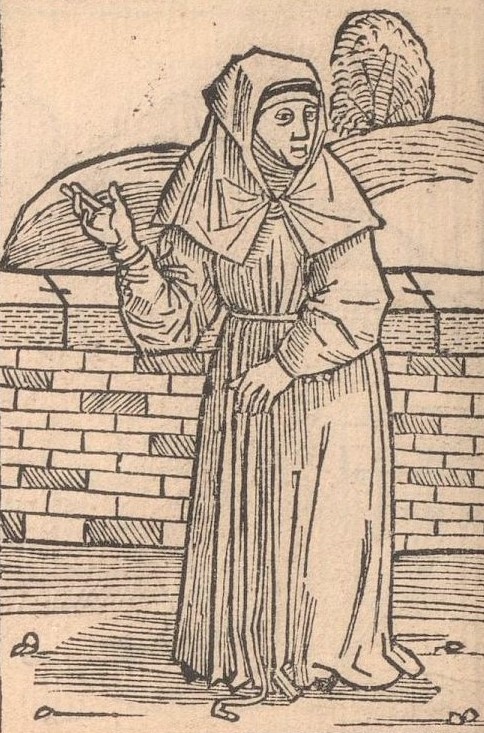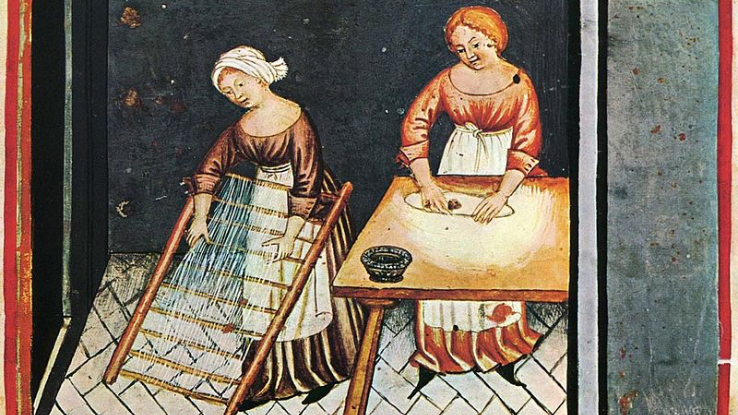We want to like the prologue to Jacques de Vitry’s hagiography (c. 1216) of thirteenth-century holy woman Marie d’Oignies. It serves as a defense of the beguines: a grassroots movement of pious women inventing new ways of living a religious life alone or in community outside a formal monastic environment. But some of Jacques’ thoughts do not sit well with modern sensibilities:
It is sufficiently demonstrated that [the beguines] clung to the Lord during the destruction of the city of Liege. Those who could not flee to the churches threw themselves into the river and chose to die rather than to incur harm to their chastity. Some jumped into dung-filled sewers and preferred to be snuffed out in stink than to be despoiled of their virginity. Despite all this, the merciful Bridegroom so deigned to look after His brides that not a single one in such a great multitude was found who suffered either death to her body or harm to her chastity. [1]
Exactly what the modern reader wants to hear: it is better for a woman to kill herself than be raped. To the vita’s target audience, however, the beguines’ actions function as proof of their commitment to a religious life outside the formal claustration and celibacy vow of a convent. Their survival is evidence for God’s approval of their way of life.
The vita of Marie, moreover, is not the only time multi-continental bishop, preacher, and very prolific author Jacques talks about a literal leap of faith in service of religious order justification. In one of his Sermones Vulgares, Jacques seeks to exhort crusaders, and especially Templar knights, to spiritual greatness:
I have heard from a certain Templar that at the very beginning of the order, while they were still poor and very fervent in religion, that he himself was coming from the city of Tyre, bringing money and alms which they had received to the city of Acre. He came to a certain place, which has been called ‘Templar’s Leap,’ ever since. For the Saracens had placed an ambush for that noble knight, in a place where on one side there was a sheer cliff and on the other the deepest sea lay below, while the Saracens besieged him from in front and behind on the narrow path. As he had no where to turn, he urged his horse with the spurs, and leapt from the lofty cliff with the horse into the depths of the sea. But the horse – as it pleased the Lord – carried him unharmed to the shore. (trans. Helen Nicholson) [2]

At first, the story appears to be a near-direct parallel to that of the Liege beguines. A Templar, facing violation of his life and mission (delivery of the money, a nice nod to the Templars’ fabled role as “the world’s first international bank”), chooses to jump from high ground into water, a plunge likely to end in his death. In this case, too, God intervenes, and the Templar’s life is preserved.
But on second glance, the Templar’s leap does not mirror the beguines’ actions so much as cast them into stark relief. In his crusade sermon, Jacques relates the knight’s mental process as he leapt off the cliff: he hoped and prayed that God would deliver him safely. The beguines, according to the bishop, hoped only that they would die.
Dyan Elliott has suggested that the story of the Liege beguines, propagated during the Albigensian Crusade against presumed Cathars in France, functions as anti-Cathar polemic. Orthodox martyrs do not die, so lay people who die in service to claimed religion are heretics, not martyrs. [3] Elliott skips over the underlying contention in her discussion of martyrdom, but it is worth drawing out in a discussion of beguines and sanctity. Jacques’ argument only works as anti-heretic polemic if the audience already stipulates the orthodoxy of the beguines. In other words, the vita prologue is a collective hagiography preaching (literally) to the choir, not an argument for an inquisitive audience. I’m more interested, though, in modern revulsion and the theological position Jacques implicitly stakes on a different topic: suicide.

Setting aside the views and experiences of women themselves, the rape of religious women was a theologically painful problem for medieval theologians—a problem bound up with suicide from the earliest centuries of Christian theology, thanks to the interplay with the classical tradition and the story of Lucretia. And Jacques and his hagiographical beguines were not necessarily on the right side. Augustine discusses the dilemma at some length in City of God I.16-19, arguing that the virtue of virginity is ultimately a matter of the will; the integrity of the body only reflects the sanctity of the will insofar as the person has control over it. [4] “We maintain that when a woman is violated while her soul admits no consent to the iniquity, but remains inviolably chaste, the sin is not hers, but his who violates her.” (I.19) He continues on to drive home his point that suicide is a mortal sin, period:
Therefore a woman who has been violated by the sin of another, and without any consent of her own, has no cause to put herself to death; much less has she cause to commit suicide in order to avoid such violation, for in that case she commits certain homicide to prevent a crime which is uncertain as yet, and not her own. (I.18)
The apparent universal survival of the Liege beguines, furthermore, is no magic arrow for Jacques to avoid the problem of actions with a desired outcome of suicide. Medieval doctrine–in point of fact, even Augustine in that same section of City of God–was clear that intention was a crucial factor in determining a sin.
This is where the comparison with the Crusade sermon becomes so revealing. The knight explicitly hopes to survive, even if he knows it is mathematically unlikely. Jacques could have given his hagiographical beguines this way out, but he did not. “Two of the enemy came to her in a boat and intended to commit vile fornication with her. But what can happen to the chaste among lions, to a lamb among wolves, to a dove among eagles? She preferred to sink again into the river than to be violated.” [5] The Liege beguines’ intention is death, or more flatly: their intention is to kill themselves. Despite this fairly flat contradiction of Church doctrine, Jacques intended this scene as an argument for the legitimacy of the beguines’ lifestyle.
The premium that Christianity places on martyrdom has long carried the uncomfortable flip side of where to draw the line between accepting one’s death and making one’s death happen. The rhetorical strategies of Jacques de Vitry in his vita of Marie d’Oignies and his Crusade sermons add an additional gendered dimension onto the dilemma. And in light of Jacques’ goal to promote the beguine movement, a comparison of the two texts suggests that when it came to arguing for orthodoxy, might heterodoxy be the best policy?
Cait Stevenson, PhD.
Medieval Institute
University of Notre Dame
—
[1] Jacques de Vitry, The Life of Marie d’Oignies, trans. Margot L. King (Peregrina, 1987), 19.
[2] H.J. Nicholson, trans., “Jacques de Vitry: Sermons to a Military Order,” De Re Militari: The Society for Medieval Military History, April 12, 2014.
[3] Dyan Elliott, Proving Woman: Female Spirituality and Inquisitional Culture in the Later Middle Ages (Princeton University Press, 2004), 65.
[4] Augustine, City of God, trans. Marcus Dods (T&T Clark, 1913), digitized here.
[5] Life of Marie d’Oignies, 19.


